#it’s not resilience
Explore tagged Tumblr posts
Text
Hey. Your brain needs to de-frag. Literally it needs you to sit there and space out.
If you want your memory or executive function to improve, stare out a window at the skyline or sidewalk or trees or birds on the electrical wires for like 20+ minutes per day. (With no other stimulation like a podcast or TV if you can manage but hey baby steps innit). If you're fortunate enough to have safe outside with any bits of nature, go stare closely at a 1 meter square of grass and trip out on the bugs and shapes of grasses and stuff.
Literally this will make you smarter. Our brains HAVE TO HAVE this zone out time to do important stuff behind the scenes. This does not happen during sleep, it's something else.
That weird pressurized feeling you get sometimes might be your brain on no defrag.
Give your brain a Daily Dose Of De-Frag.
#brains#executive function#memory#adhd#mental health#neurodivergent#thanks @the-sacred-now for bringing this up in science shapes the other day#neurology#defrag#daily dose of defrag#now more than ever#stay strong#curate resilience
44K notes
·
View notes
Text

#yemen#jerusalem#tel aviv#current events#palestine#free palestine#gaza#free gaza#news on gaza#palestine news#news update#war news#war on gaza#palestinian resilience#palestinian food#food#food videos#hopecore
50K notes
·
View notes
Text



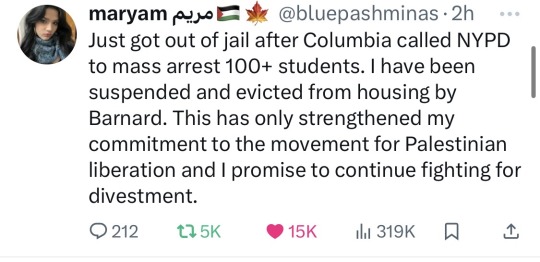

FUCK YEAH COLUMBIA UNI STUDENTS!!!!!!
#free palestine#ceasefire now#palestine#columbia university#solidarity#activism#protest#genuinely sobbing at the resilience and organization of these students#it’s so beautiful to see
42K notes
·
View notes
Text
it is so strange to go to the grocery store and realize that 65 percent of the people there just hate me and will always hate me. i mean it’s not like i didn’t know before. but i don’t think people in blue states will ever understand that level of sheer hopelessness and total demoralization and i wouldn’t wish it on them. if you love or even just know a southerner please realize that we can hear what you’re saying about us and it’s not just one wall of bigots here. people are already talking about refusing aid to states like texas and florida in the case of another natural disaster and i am begging you to realize that we fucking live here too.
#about to clock in at the BOOKSTORE in KENTUCKY where i WORK. surely that’ll be fine.#it’s not like my boss is an ex cop or anything. it’s not like we sell out of hillbilly elegy weekly. i’m sure it’ll be fine.#god ok resilience whatever fine ok
6K notes
·
View notes
Text

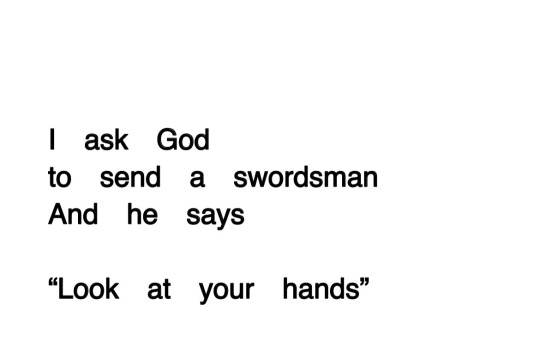



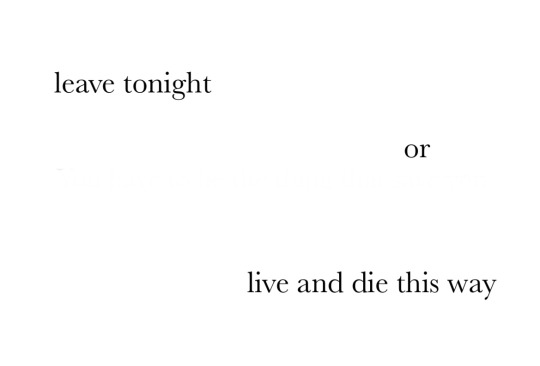


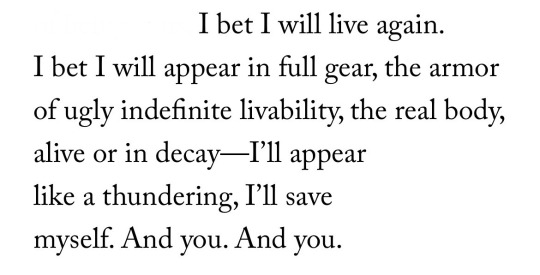

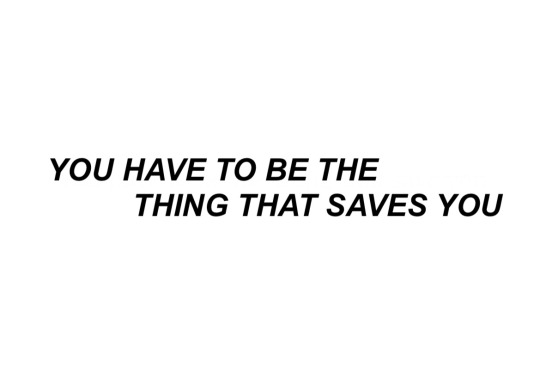
BE STRONG, BE BRAVE
Poem “Problem Area” (2016), in Last Sext, by Melissa Broder; // Unknown; // “The Waves” (1931), by Virgina Woolf; // “Notebooks” (2017), by Tennessee Williams; // “Fast Car” (1988), by Tracy Chapman; // “The American Crisis” (1776), by Thomas Paine; // Quote by @maplepecanpastry /// Stills from “Joan of Arc” (1948), by Victor Fleming, starring Ingrid Bergman
#web weave#webweaving#webweave#web weaving#on been brave#on been strong#be brave#be strong#resilience#courage#be your knight#be your hero#take a deep breath#god help me#and go#do it yourself#aesthetic#spilled thoughts#poetry#poem#spilled poetry#spilled ink#quote
4K notes
·
View notes
Text



𝑫𝑹𝑬𝑾 𝑺𝑻𝑨𝑹𝑲𝑬𝒀 & 𝑴𝑨𝑫𝑬𝑳𝒀𝑵 𝑪𝑳𝑰𝑵𝑬 . Outer Banks ( 2020 – ) .
#drew starkey#madelyn cline#rafe cameron#sarah cameron#sarah routledge#madelynclineedit#drewstarkeyedit#rafecameronedit#sarahcameronedit#sarahroutledgeedit#outer banks#obx#outerbanksedit#obxedit#tvgifs#tv.#mine.#my gifs.#muse.#disconsolate.#resilient.#spoilers.
5K notes
·
View notes
Text
As relentless rains pounded LA, the city’s “sponge” infrastructure helped gather 8.6 billion gallons of water—enough to sustain over 100,000 households for a year.
Earlier this month, the future fell on Los Angeles. A long band of moisture in the sky, known as an atmospheric river, dumped 9 inches of rain on the city over three days—over half of what the city typically gets in a year. It’s the kind of extreme rainfall that’ll get ever more extreme as the planet warms.
The city’s water managers, though, were ready and waiting. Like other urban areas around the world, in recent years LA has been transforming into a “sponge city,” replacing impermeable surfaces, like concrete, with permeable ones, like dirt and plants. It has also built out “spreading grounds,” where water accumulates and soaks into the earth.
With traditional dams and all that newfangled spongy infrastructure, between February 4 and 7 the metropolis captured 8.6 billion gallons of stormwater, enough to provide water to 106,000 households for a year. For the rainy season in total, LA has accumulated 14.7 billion gallons.
Long reliant on snowmelt and river water piped in from afar, LA is on a quest to produce as much water as it can locally. “There's going to be a lot more rain and a lot less snow, which is going to alter the way we capture snowmelt and the aqueduct water,” says Art Castro, manager of watershed management at the Los Angeles Department of Water and Power. “Dams and spreading grounds are the workhorses of local stormwater capture for either flood protection or water supply.”
Centuries of urban-planning dogma dictates using gutters, sewers, and other infrastructure to funnel rainwater out of a metropolis as quickly as possible to prevent flooding. Given the increasingly catastrophic urban flooding seen around the world, though, that clearly isn’t working anymore, so now planners are finding clever ways to capture stormwater, treating it as an asset instead of a liability. “The problem of urban hydrology is caused by a thousand small cuts,” says Michael Kiparsky, director of the Wheeler Water Institute at UC Berkeley. “No one driveway or roof in and of itself causes massive alteration of the hydrologic cycle. But combine millions of them in one area and it does. Maybe we can solve that problem with a thousand Band-Aids.”
Or in this case, sponges. The trick to making a city more absorbent is to add more gardens and other green spaces that allow water to percolate into underlying aquifers—porous subterranean materials that can hold water—which a city can then draw from in times of need. Engineers are also greening up medians and roadside areas to soak up the water that’d normally rush off streets, into sewers, and eventually out to sea...
To exploit all that free water falling from the sky, the LADWP has carved out big patches of brown in the concrete jungle. Stormwater is piped into these spreading grounds and accumulates in dirt basins. That allows it to slowly soak into the underlying aquifer, which acts as a sort of natural underground tank that can hold 28 billion gallons of water.
During a storm, the city is also gathering water in dams, some of which it diverts into the spreading grounds. “After the storm comes by, and it's a bright sunny day, you’ll still see water being released into a channel and diverted into the spreading grounds,” says Castro. That way, water moves from a reservoir where it’s exposed to sunlight and evaporation, into an aquifer where it’s banked safely underground.
On a smaller scale, LADWP has been experimenting with turning parks into mini spreading grounds, diverting stormwater there to soak into subterranean cisterns or chambers. It’s also deploying green spaces along roadways, which have the additional benefit of mitigating flooding in a neighborhood: The less concrete and the more dirt and plants, the more the built environment can soak up stormwater like the actual environment naturally does.
As an added benefit, deploying more of these green spaces, along with urban gardens, improves the mental health of residents. Plants here also “sweat,” cooling the area and beating back the urban heat island effect—the tendency for concrete to absorb solar energy and slowly release it at night. By reducing summer temperatures, you improve the physical health of residents. “The more trees, the more shade, the less heat island effect,” says Castro. “Sometimes when it’s 90 degrees in the middle of summer, it could get up to 110 underneath a bus stop.”
LA’s far from alone in going spongy. Pittsburgh is also deploying more rain gardens, and where they absolutely must have a hard surface—sidewalks, parking lots, etc.—they’re using special concrete bricks that allow water to seep through. And a growing number of municipalities are scrutinizing properties and charging owners fees if they have excessive impermeable surfaces like pavement, thus incentivizing the switch to permeable surfaces like plots of native plants or urban gardens for producing more food locally.
So the old way of stormwater management isn’t just increasingly dangerous and ineffective as the planet warms and storms get more intense—it stands in the way of a more beautiful, less sweltering, more sustainable urban landscape. LA, of all places, is showing the world there’s a better way.
-via Wired, February 19, 2024
#california#los angeles#water#rainfall#extreme weather#rain#atmospheric science#meteorology#infrastructure#green infrastructure#climate change#climate action#climate resilient#climate emergency#urban#urban landscape#flooding#flood warning#natural disasters#environmental news#climate news#good news#hope#solarpunk#hopepunk#ecopunk#sustainability#urban planning#city planning#urbanism
14K notes
·
View notes
Text
If you don’t get it, you will and I hope we are friends when you do
I stupidly add another song to my running playlist as if I’ll be listening to it while running anytime soon because I don’t want to start another playlist. I can’t seem to go about stringing together this blog post and yes, I think it’s actually ok for me to call that out in the post itself. I’ve noticed I’ve also been struggling with grammar and editing. My blog, this blog, is meant to be messy and raw, almost like you’re reading straight from my journal which I never edited any journal I ever wrote or will write.
Yesterday a bunch of things helped me work through old “scars” left over from my cancer battle but I also learned new things about myself and life. I also broke down crying because I feel like nothing has changed and I’ve learned nothing and my life has amounted to nothing. I am trapped in my house, typically on one floor of my house, laying down almost all the time. When people ask me to be positive, keep good spirits, or other advice, I know it is well meant- but I’m realistic. I don’t believe “positive” is a personality trait and I don’t think wearing rose-colored glasses cures cancer. It takes a lot of energy to just be because I’m struggling to breathe all the time. So, no, I’m just gonna be Meghan and I’ll have whatever outlook or feeling I have right now. That doesn’t mean I’m licensed to be an asshole. It just means I do not have to spend energy making other people feel comfortable.
In a season that I’m hearing my friends doing fun things, it’s hard not to feel envious and my insecurity tells me even if I was well, I’d still be chasing people. My next entries may or may not deal with abandonment, medical trauma and insecurity but I’ve been struggling to write these posts. I’ve been going to therapy while not working and for those who think I should spend all my time being sick if I’m sick and not doing therapy- I’m still sick in therapy, I’m just also working on my brain that needs a lot of healing too. And honestly people this fucking shit is hard. My life completely dead stopped and I still don’t know completely know why or for how long.
We will all get sick in our lives, so sick that our lives will alter permanently or temporarily. Some of us will do it only once, some of us multiple times. I’m this person because my life was altered already permanently by illness. I will be that person, hopefully, at the end of this, with more to share with those willing to read it.
0 notes
Text


WE ARE STILL HERE
#pride#resilience#i'm thinking these would make good cards or stickers#leave them all scattered around in public places#particularly in certain areas of the country#lgbt#lgbtq#lgbtqia#trans#queer
2K notes
·
View notes
Text
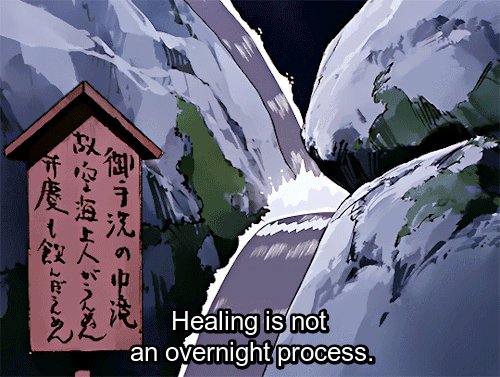
#healing#journey#growth#progress#patience#self-compassion#innerstrength#resilience#emotionalwellbeing
13K notes
·
View notes
Text

3K notes
·
View notes
Text
When you don’t speak up and your words become choked in your throat, you’re blocking your natural flow. When you go to the birthday dinner of the friend (who’s not really your friend) even though your soul is screaming not to, you block your natural flow. When you accept the soul-destroying job for money, despite promising yourself to take a risk on your business idea… You block your natural flow. And when this becomes a lifestyle, this is how you become the healthy person who is suddenly struck down with a serious health issue, this is how you end up with anxiety and depression, and lethargy, feeling so beat down by the world. When the truth is you simply betrayed yourself, you live for the world instead of your heart. But here’s the hot take, being in your flow is your superpower. It’s how you collapse timelines and completely transform your life in 3-6 months, it’s how you position yourself to be in the right place at the right time, it’s how you live authentically no matter how crazy it looks to everyone around you. Your soul is speaking to you in little whispers throughout the day, practise listening and taking actions from that place, the little whispers are guiding you back to your natural flow and from this place, to your souls home, to your freedom.
#levelupjourney#manifestyourreality#levelup#manifesting#lawofattraction#growthmindset#levelup confidence lawofattraction powerofthemind#manifestingmindset#soul#life purpose#acceptance#resilience#gratitude#understanding
700 notes
·
View notes
Text

#yemen#jerusalem#tel aviv#current events#palestine#free palestine#gaza#free gaza#news on gaza#palestine news#news update#war news#war on gaza#palestinian resilience#palestinian resistance#tiktok
25K notes
·
View notes
Text
People hate Jewish resilience. They hate us in general, but they *especially* hate our resilience.
#sorry you hate that we've existed for thousands of years and survived your attempts to destroy us#sorry you hate that we still sing and dance while we stamp out your name#jumblr#judaism#antisemitism#jewish resilience#we will dance again
2K notes
·
View notes
Text
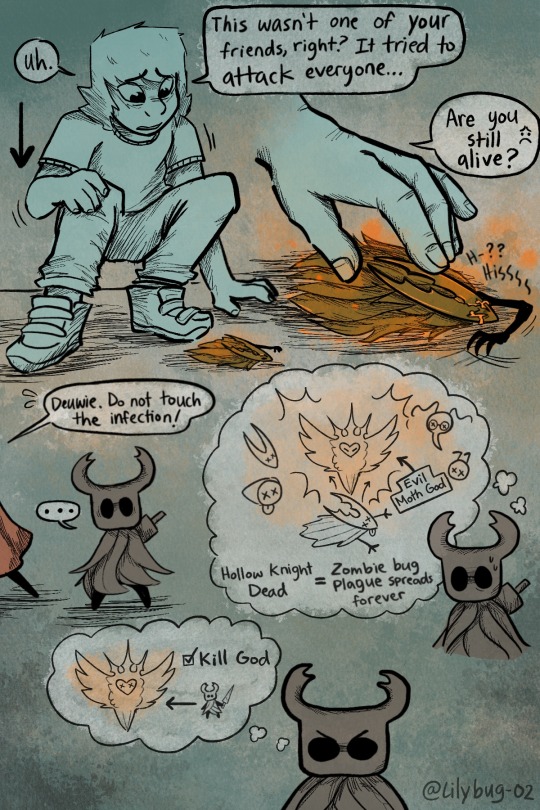
New Goal Acquired!
Bug Fact: The scarlet lily beetle (or better yet the lily bug ;P) is a leaf beetle that eats the leaves, stem, buds, and flowers of lilies.
First || Prev // Next
Masterpost
#The Knight has a new plan! KILL GOD#this is the most the knight has emoted here lmao. Big eyebrows#Dewi may have put the HK out of commission but he still hoped he didn't kill the bug outright#most resilient bugs can handle a few crushing blows....even if they may break a few legs#HK/Rad is very confused. Big creature literally tries to kill them and then immediately regrets decision. huh???#hollow knight#hollow knight humans#dewi's adventures in hollow knight#hollow knight knight#hollow knight hollow#dewi#my art#art#comic#hk spoilers#hollow knight spoilers#spoilers
2K notes
·
View notes